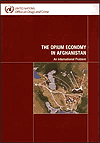| |
BOOK
REVIEW
The curse
of the poppy
The Opium Economy in Afghanistan. An
International Problem by the United
Nations Office on Drugs and Crime
Reviewed by Sreeram Chaulia
 It
is no cliche that opium has ruined many an
individual, family, society and nation. The
history of modern China bears graphic testimony.
More recently, Myanmar and Colombia have
suffered profusely from the proliferation of
opium cultivation and trafficking that fills the
pockets of military factions. But the most
definitive test case of our times for proof of
narco-terrorism and its power of destroying a
country is Afghanistan, producer of 75 percent
of global opium stocks and not coincidentally
the victim of the worst kind of warlordism,
religious fundamentalism and civil society
devastation. It
is no cliche that opium has ruined many an
individual, family, society and nation. The
history of modern China bears graphic testimony.
More recently, Myanmar and Colombia have
suffered profusely from the proliferation of
opium cultivation and trafficking that fills the
pockets of military factions. But the most
definitive test case of our times for proof of
narco-terrorism and its power of destroying a
country is Afghanistan, producer of 75 percent
of global opium stocks and not coincidentally
the victim of the worst kind of warlordism,
religious fundamentalism and civil society
devastation.
This comprehensive new book by the UN Office on
Drugs and Crime (UNODC) methodically delves into
the various components of Afghanistan's opium
economy - cultivation, production, finance,
trade and consumption - and explains its
obnoxious impact both at home and in neighboring
countries. It argues that dismantling the opium
economy must be done with the instruments of
democracy, rule of law and development.
"National efforts will not be enough. The
problem is international." (p 1) Severe
negative externalities of Afghan opium have
converted it into a world problem soluble only
through concerted international action to stem
both supply and demand sides.
Afghanistan never had an "opium
culture" per se before 1980 (although
Badakshan province is known in legend for tipsy
spirits). Lack of effective central government,
widespread loss of life, infrastructure
decimation and forced displacement of people in
the last 22 years created conditions in which
the only crop that promises a decent income is
opium. "The more the overall economic
situation deteriorated, the more farmers opted
as a strategy for survival for growing opium
poppy." (p 90) Opium is weather-resistant,
reliable, easy to transport and sell compared to
other crops. Involvement of cheap family labor
(women and girls are expected to work free
without wages or in-kind compensation) saves on
costs of production and boosts profitability. In
1999, the average income per opium producing
farmer was $1,075, which went up to $7,400 in
2001. These are extraordinary revenues in a
country where the average wage does not exceed
$2 per day. "Opium is an insurance against
poverty and hunger." (p 10)
The mujahideen use the production and sale of
opium to finance weapons needs. Islam prohibits
intoxicating drugs, but weakening social and
legal constraints increase tolerance for opium
as one of the few commodities that can generate
enough income for buying sophisticated Western
arms. Opium and arms are often smuggled along
the same routes - "arms into Afghanistan
and opium out of Afghanistan". (p 127)
Since 1996, warlords already involved in opium
trade surrendered to the Taliban in exchange for
the permit to continue their lucrative
contraband trade. The Taliban, who did not
disturb the opium economy as long as taxes could
be levied on production, transit and trade,
reaped the largest profits out of opium. Strong
criticism from the international community and
the threat of even stronger UN sanctions forced
the Taliban to decree a temporary ban on opium
production in July 2000, but massive re-planting
of the poppy began as soon as the Taliban were
deposed in late 2001.
Lack of a functioning financial system in
Afghanistan has raised the importance of opium
in the informal capital markets. Opium is
"the only form of credit available",
especially as the Taliban implemented a narrow
interpretation of interest-free Islamic banking.
Advance sales to "narco-usurers" based
on collateral of the future poppy crop (salaam
payments) comprise 60 percent of all loans taken
out in Nangarhar and Kandahar provinces. So deep
is indebtedness in rural Afghanistan that
"the frequent solution to a household's
debt problem is to expand opium poppy
cultivation". (p 123)
Like the military entrepreneurs, greed and
desire for social status motivate opium traders.
UN interviews reveal that 85 percent of southern
Afghan opium traders perform the expensive hajj
pilgrimage and enjoy access to power, reputation
and respect in their localities. Fifty percent
of the traders have two to three wives, the
number of wives a man can afford is a status
symbol in Afghanistan. Hundred percent of the
traders own at least a car, a motorcycle or a
tractor and have larger than average land
holdings. In eastern Afghanistan, an average
opium trader involved in rapid turnover trade
(purchase from farmers and immediate sale in
nearby markets) can make an annual profit of
$1,000 per year, a figure much smaller than the
profits from smuggling opium to border regions
or across into Pakistan, Iran and Central Asia.
From the mid-1990s, massive heroin manufacture
(obtained by purifying morphine, an opium
extract) has taken off in Afghanistan, with the
prospect of even greater profits than opium. The
high morphine content of Afghan opium gives it a
comparative advantage in illicit heroin trade.
Pure heroin prices rise sevenfold once smugglers
get it across Afghanistan into Iran.
"Smuggling of one kilogram of opium to
Tehran is equivalent to two years of income in
Afghanistan while smuggling one kilogram of
heroin is equivalent to four years of
income." (p 141) The magnitude of profits
in the opium economy means that legitimate
income alternatives can never replace the
windfalls associated with drugs.
Drug consumption in Afghanistan has increased
strongly in recent years owing to cheap and
universal availability of illicit opium, the
mass return of refugees who developed addiction
in Pakistan and Iran, and the use of opiates as
painkillers in the absence of basic medication
and health care facilities. Opium is abused by
0.5 percent and heroin by 0.1 percent of the
adult population, proportionately lower than in
Pakistan (0.9 percent), Central Asia (0.9
percent) or Iran (1.7 to 2.8 percent). Abuse of
hashish (9.1 percent) and pyschotropic
substances (1.8 percent) is also rising in
Afghanistan.
Various studies show that countries around
Afghanistan that are the primary recipients of
illegal opium exports have paid a heavy toll in
economic development. Neighboring countries are
responsible for 61 percent of global seizures of
opiates, but taken together with Europe, Near
and Middle East and Central Asia, they
contribute just 1 percent of the aggregated GDP
of these three regions, clearly indicating the
economic burden imposed by drug trafficking.
Iran, which spends the most against drug
trafficking, has the highest per capita income
growth rate among Afghanistan's neighbors. It
has paid a big price for drug interdiction in
human and monetary terms, losing 3,000 law
enforcement personnel in two decades and
$250-$300 million in the year 2000 alone as
direct costs of drug control. Total profits made
by Iranian trafficking gangs in 2001 may have
amounted to $1.3 billion, equivalent to 1.3
percent of the national income. Criminal
Pakistani groups earn roughly $400 million per
annum from opium trafficking, equivalent to 0.7
percent of GDP. Their Central Asian counterparts
earn in excess of $2 billion a year, a gross
trafficking sum equivalent to 7 percent of the
region's aggregate GDP.
Black money from drug trafficking has an
inherent potential to destabilize the state and
socio-economic paraphernalia. Corruption,
violence and slush money have negative
repercussions on legitimate investment and thus
compromise economic growth in the long run.
Full-scale electoral frauds perpetrated to
install administrations that are acceptable to
major trafficking networks (a la Russia today)
are possibilities. Acquisitive crime, gang
warfare, extortion and kidnapping, already
features of Afghanistan and its neighboring
parts, can become institutionalized if the opium
economy is not tamed. Capital formation
(domestic investment) in the region averages 15
percent of GDP, ie lower than that for low and
middle-income countries. Economic growth rates
of Afghanistan's neighbors declined by 4 percent
per annum between 1990 and 2000, drug
trafficking undoubtedly acting as a contributing
factor.
The human losses in Afghanistan's neighborhood
have also been acute. Iran has 1.2 million
chronic opiate abusers (2.8 percent of adult
population), with Central Asia and Pakistan
having addiction prevalence rates of 0.9 percent
of respective populations above the age of 15.
Overall health budgets in these countries are
hardly sufficient to deal with ordinary
ailments, let alone provide the additional
expenses for dealing with opiate abuse. The
opium-generated health crisis is particularly
acute in an undeveloped country like Tajikistan,
which has undergone a seven-fold increase in
drug abuse in the decade of the 1990s (annual
addiction growth rate of 17 percent).
Heroin abuse is now more common than opium
consumption across Pakistan and as many as 15
percent of heroin users report using injecting
needles as administration routes. UNAIDS finds
"no data to indicate that, aside from
injecting drug use (IDU) transmission, there is
any other significant transmission of HIV
occurring in Pakistan at present". (p195)
Central Asian Republics are witnessing
increasing rates of IDU, carrying high risks of
blood-borne diseases. Eight-eight percent of
newly recorded HIV cases in Central Asia are
related to IDU. Iran's HIV/AIDS epidemic is
"driven by its drug problem". (p196)
Afghanistan's surroundings face significant
risks of sexual transmission of HIV from IDU to
the general population. IDU-related HIV rates in
the Russian Federation and other parts of the
former USSR that import Afghan opiates are the
highest in the world.
As long as opium production exists in
Afghanistan, the threat to security of
neighboring countries will remain. Afghanistan's
large poppy harvest in 2002 implies that they
"will suffer some time to come from the
consequences". (p 192)
What is the way out of this web of debauchery,
decline and criminalization? UNODC has several
recommendations. Supporting central institutions
of the state within Afghanistan to establish
effective government control over poppy
cultivating areas is a pre-requisite.
Non-extension of the International Security
Assistance Force (ISAF) beyond Kabul,
tortoise-paced headway on a new national army,
and parceling of authority to regional warlords
are not helping to acheive this objective. A
sustainable rural economy has to be developed,
encompassing credit schemes for farmers, sources
of income for the landless, commodity markets
free of the perverse incentives of opium,
functioning banking systems, stable currency and
firm enforcement of bans on opium markets.
The image of opium traders needs transmuting
from Robin Hood heroes to criminals who bring
misery to many people across the world.
Labor-intensive public work programs and school
exams should be timed in the April-May period to
correspond with the opium harvesting season.
Costing the labor of girls and women is
essential to disrupt the structural advantages
of opium production. The principal lesson is
that "an integrated drug control approach
will have to be linked to the mainstream of all
other development efforts to rebuild
Afghanistan". (p 210)
The book concludes by noting that interventions
to reduce the supply-push of opiates depend on
measures to reduce the demand-pull, especially
in European markets. This is akin to the
well-documented need to attenuate demand of
"conflict diamonds" from Angola,
Sierra Leone and the Congo in European and North
American markets if African civil wars are to be
suffocated.
The UNODC should be praised for this
encyclopedic reference report loaded with
empirical tables, graphs and maps. It serves to
remind policy makers and researchers that the
Afghan tragedy will never be over unless the
sinister nexus of drugs and thugs is busted.
The Opium Economy in Afghanistan. An
International Problem by the United Nations
Office on Drugs and Crime, Vienna. 2003. ISBN:
92-1-148157-0. Price: US $25, 226 pages.
(©2003 Asia Times Online Co, Ltd. All rights
reserved. Please contact [email protected]
for information on our sales and syndication
policies.)
|
| |
|
|
 |
|




 It
is no cliche that opium has ruined many an
individual, family, society and nation. The
history of modern China bears graphic testimony.
More recently, Myanmar and Colombia have
suffered profusely from the proliferation of
opium cultivation and trafficking that fills the
pockets of military factions. But the most
definitive test case of our times for proof of
narco-terrorism and its power of destroying a
country is Afghanistan, producer of 75 percent
of global opium stocks and not coincidentally
the victim of the worst kind of warlordism,
religious fundamentalism and civil society
devastation.
It
is no cliche that opium has ruined many an
individual, family, society and nation. The
history of modern China bears graphic testimony.
More recently, Myanmar and Colombia have
suffered profusely from the proliferation of
opium cultivation and trafficking that fills the
pockets of military factions. But the most
definitive test case of our times for proof of
narco-terrorism and its power of destroying a
country is Afghanistan, producer of 75 percent
of global opium stocks and not coincidentally
the victim of the worst kind of warlordism,
religious fundamentalism and civil society
devastation.


